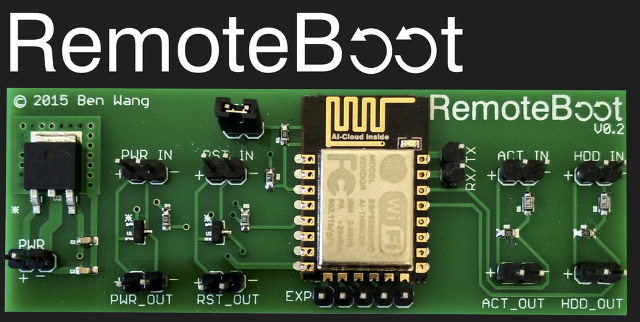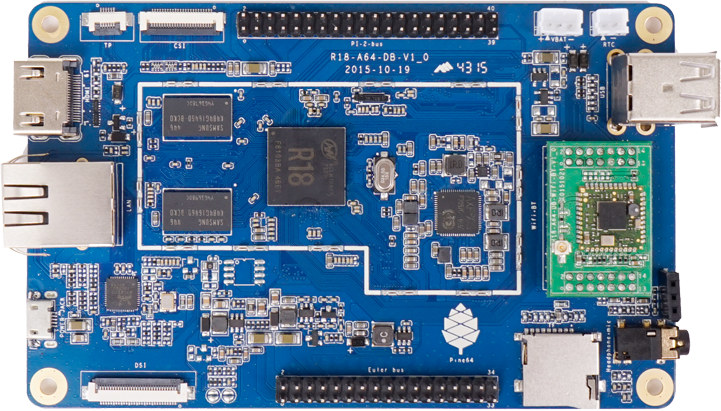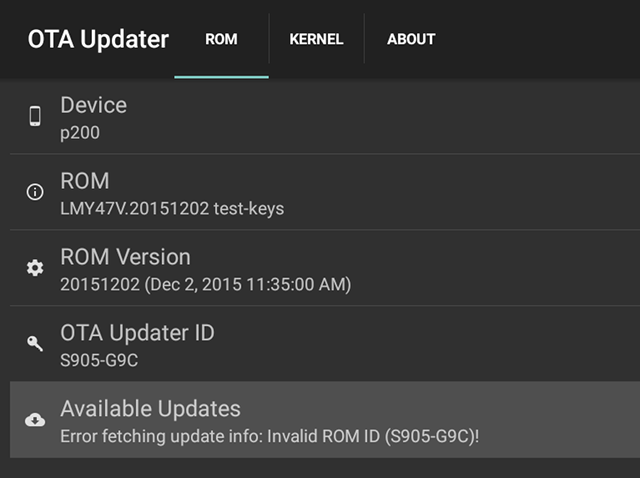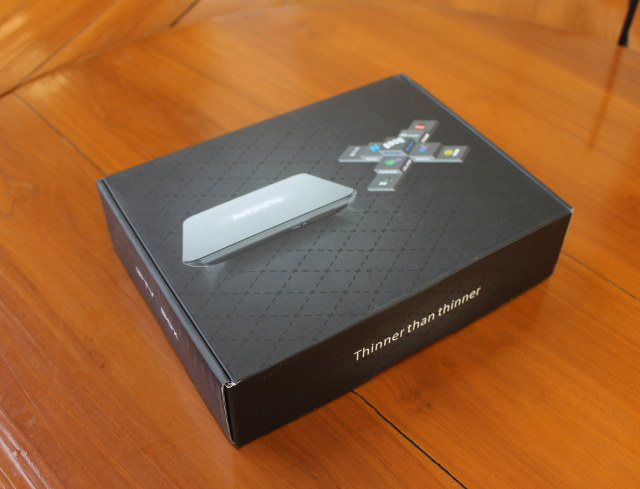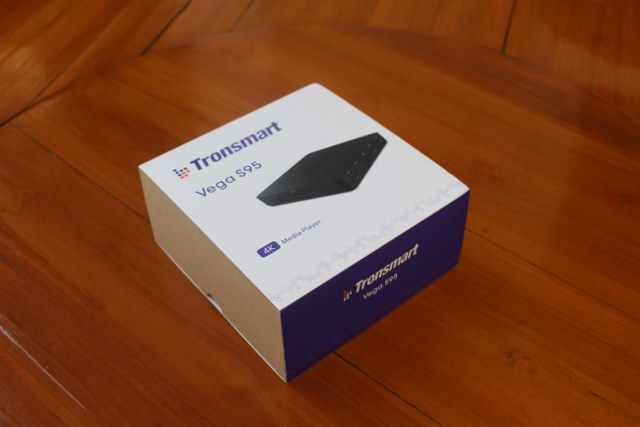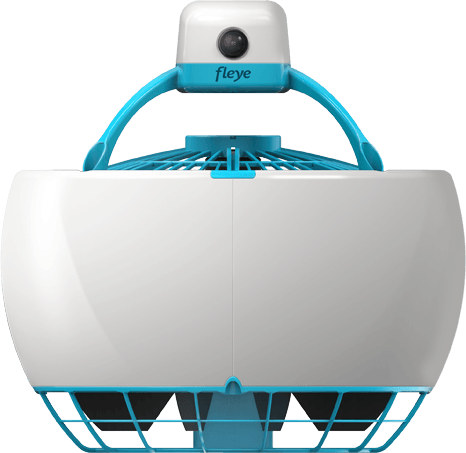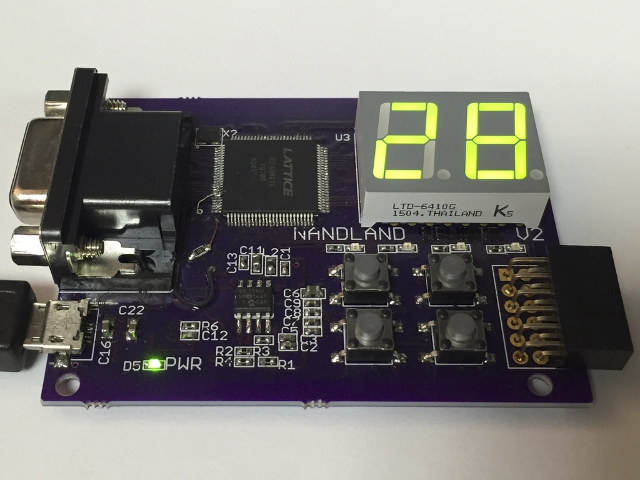Wake-on-LAN is a features that allows you to remotely start your computer by sending magic network packets to the LAN interface, but it requires support from your motherboard. So Ben Wang, an Australian high-school student, decided to make his own little board called RemoteBoot to power off and reboot computers that do not support the feature, or even access the serial console on embedded boards. The board is pretty basic and includes an ESP8266 module: ESP12-E WiFi module 2x digital switching outputs for power and reset buttons 2x digital protected inputs for power and activity LEDs 3x extra general purpose inputs/outputs broken out Tx/Rx for serial console There’s also a feature disabled by default, where a watchdog monitor the activity LED, and automatically reboots the computer after a user-defined timeout. Everything will be control via a simple web interface, and if you have multiple RemoteBoot devices, access to Remoteboot Cloud […]
PINE A64 Development Board Kickstarter Campaign is Up
As previously announced, PINE64 $15 64-bit ARM Linux computer was due to launch on December 9, and the Kickstarter campaign is now up, and the shipping costs are $7 to the US, and $12 to the rest of the world. The name have changed to PINE A64 and PINE A64+ since the first announcement, but the specifications have mostly not changed for th two boards with an Allwinner quad core Cortex A53 processor, 512MB to 1GB RAM, a micro SD slot for storage, Gigabit Ethernet, HDMI 1.4, USB ports, and some other expansion headers for I/Os, displays or cameras. The PINE A64+ however now has an option for 2GB for $29, and we’ve got a bit more information about optional modules and accessories: Wireless module with WiFi and Bluetooth adapter Zwave adapter 7″ LCD touchpanel (PINE64+ only) Dry contact I/O board 5MP MIPI CSI camera Various sensors Various remote controls […]
OTA Updater is an Open Source App to Update Android Firmware
Yesterday, I received G9C TV box, but since Google Play is not exactly working perfectly, I decided to postpone the review until I get a new firmware. I did notice however that the firmware did not include Update&Backup app as found on K1 Plus, but instead an OTA Updater app, also called OTA Update Center, that happens to be an open source app with source code available on Github. Android already has a framework for OTA updates, but that app could make it easier implement OTA firmware updates for your own platform, or simply because you want to push your firmware, or as some people called them “ROM”, to multiple users. The software will allow you to update the “ROM” and kernel as long as both updates are configured correctly, which is apparently not the case for S905-G9C… The setup instructions are quite simple, explained on OTA Update Center website, […]
Antutu 6.0 Release Brings New Benchmarks and Different Scores
When Antutu 5.0 was released, it added some new tests such a single thread performance, and revamped its 2D and 3D graphics test among others, and that meant the new scores were could not be compared to Antutu 4.x. If you now download Antutu from the play store, you’ll get Antutu 6.0 and Antutu 3DBench apps, which handle the 3D graphics test separately. I can confirm Antutu 6.0 scores cannot be compared with Antutu 5.x ones, as Tronsmart Vega S95 Telos TV box got 36,741 points in Antutu 6.0, while typically competitors achieved 28,000 to 29,000 points in Antutu 5.7.1. There are now 4 main section in the benchmark: 3D, UX, CPU and RAM, so the details are much different. One neatr featuer is the QR core of the result, which allows you to keep a link with the complete result, in this case: http://antutu.com/qr/?c=18af306ecb85f6d42df2d4a1285d10eed87bf15e. And if we do look […]
MXQ S905 / G9C 4K Android Media Player Unboxing and Teardown
Beside Tronsmart Vega S95 Telos, I’ve received another Amlogic S905 device with MXQ G9C, which was the first Amlogic S905 TV box to have surfaces in the news back in June, and a sample has been sent to me by Shenzhen Tomato. Since the company provides ODM/OEM services instead of catering to end users, the specs are flexible, but the device I received is with the default configuration namely 1GB RAM and 8GB flash, and with similar specs to Beelink MINI MX or KI Plus for example. Today, I’ll start by checking out the hardware, before reviewing the full package a little later. MXQ S905 / G9C TV Box Unboxing I received the parcel via DHL, with the device in a retail white brand package reading “MXQ”, “S905”, and “IPTV box”, with some features on the back such as Airplay, DLNA, Miracast, or Widewine, Playready, and Verimatrix. But I’m pretty […]
Tronsmart Vega S95 Telos TV Box Unboxing and Teardown
Tronsmart Vega S95 Telos is an Android mini PC powered by Amlogic S905 quad core Cortex A53 processor, but contrary to the two other S905 device I previously reviewed, namely K1 Plus and MINI MX, it’s not been designed for the ultra low end, as it comes with 2GB RAM, 16 GB eMMC flash, 802.11ac WiFi, Gigabit Ethernet, and a SATA port. GeekBuying sent me one sample for review, and I’ll start with some pictures of the package, device, and board, before running it through a full test procedure. Tronsmart Vega S95 Telos Unboxing I got the box via DHL in the following package with makes it clear it’s a 4K media player. The box comes with a simple IR remote control requiring two AAA batteries, an HDMI cable, a SATA cable for laptop drives, a 12V/2A power supply, and a user’s manual in English. The device looks somewhat like […]
Fleye is a Safe, Robust and Developer Friendly Drone Powered by NXP i.MX6 Processor (Crowdfunding)
In most cases, it’s a pretty bad idea to touch a drone while it’s flying, as you could potentially hurt yourself and others with the blades, so a startup based in Belgium has decided to design a safe drone with the blades hidden under a shell surrounded by protective grids, and with features such as obstacles avoidance. The design also makes the drone sturdier, and less prone to breakage should it fall or hit obstacles. The drone, dubbed Fleye, is based on NXP i.MX6 dual core processor, runs a Linux OS built with the Yocto Project, and the company also plans to provide APIs, and mobile SDKs to allow the developer community to experiment with the drone, and/or create mobile apps. Main hardware features of Fleye drone: SoC – Freescale NXP i.MX6 dual or quad core ARM Cortex A9 processor @ 800 MHz with Vivante GPU System Memory – 512 […]
Nandland Go Board is a $50 Board for Learning FPGA, VHDL & Verilog Programming (Crowdfunding)
There are many FPGA boards on the market at various price points, but many assume you already have the technical knowledge to program the bard with Verilog or VHDL, and may not be suited to beginners. Nandland Go Board is a $50 board that targets beginners with tutorials to get started with blinking LEDs, controlling buttons, received data through the UART interface, showing display patterns via the VGA interface and more. Go Board specifications: FPGA – Lattice ICE40 HX1K with 1280 logic cells, 64Kbit RAM, and one PLL. Storage – 1Mb flash Clock – 25 MHz on-board clock Video Output – VGA Connector Display – Dual 7-Segment LED Display USB – 1x micro USB connector for power, communication, and programming Expansion – PMOD connector Misc – 4x user LEDs, 4x push buttons Power – 5V via micro USB port Dimensions – N/A The board will be programmed using Lattice Semi […]


